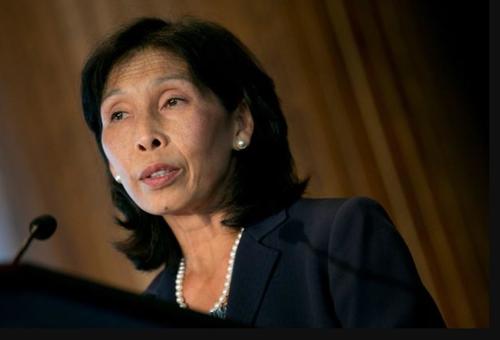by TYLER DURDEN
As bitcoin prices surge in anticipation of the SEC finally approving a bitcoin ETF (after years of turning down one application after another), one top crypto regulator from Treasury – Treasury Undersecretary for Domestic Finance Nellie Liang – offered a frank explanation for why the Treasury Department sees stablecoins as an important locus for crypto regulation. The issue is that stablecoins solve a critical problem for crypto: they’re rarely volatile, by design. Bloomberg reported earlier this month that tether, one of the biggest stablecoins, appears to be a massive Ponzi scheme. Although it saw some volatility in response, on Thursday, tether was trading right around $1.
Why is it that tether didn’t collapse after being accused of being a Ponzi scheme (not like this is even the first time)? Because stable coins like tether have become a central part of the crypto-trading economy, allowing traders to move easily into and out of positions in different coins without ever needing to re-convert their crypto to US dollars. As Liang put it, stablecoins play a “foundational” role in the crypto economy. While they’re mostly used for trading right now, the Treasury is keeping a close eye on whether stablecoins start being used for commerce, something that might trigger a backlash from the Treasury since it would be a sign that a real competitor to the US dollar might actually be emerging.
As Liang added, stablecoins being used for payments (like Mark Zuckerberg infamously tried to do) “raises a whole set of issues”.
“We believe they’re kind of foundational to crypto and future crypto services,” Liang said Thursday during a virtual event sponsored by the Institute of International Finance. “They’re being used mostly for crypto trading currently. They also have the potential and have started to be used for payments — and may be widely used for payments, and that raises a whole set of issues that the President.”
“They’re being used mostly for crypto trading currently. They also have the potential and have started to be used for payments — and may be widely used for payments, and that raises a whole set of issues that the President’s Working Group wanted to focus on,” she said.
At this point, more regulation for the crypto community seems virtually inevitable with Janet Yellen running Treasury and Gary Gensler running the SEC. President Biden and his advisors have even considered imposing an entire new regulatory framework for crypto via executive fiatn (no pun intended).
Liang is a member of the President’s Working Group on crypto regulation. For those who aren’t familiar with it, the working group includes the heads of Treasury and several other federal agencies. The group is planning to issue a report on stablecoins by the end of the month. In addition to the policy-setting team, the DoJ has put together a task force to combat cryptocurrency-related crime as well.
Media reports have suggested that the Biden Administration plans to regulate stablecoins like banks. He’s also reportedly considered hiring a “crypto czar”
But whatever happens, keep in mind: whatever lip-service federal policymakers give about stablecoins (including the FedCoin which is being studied by the central bank) being a key part of innovation, in reality, they see it as one thing: a threat.






